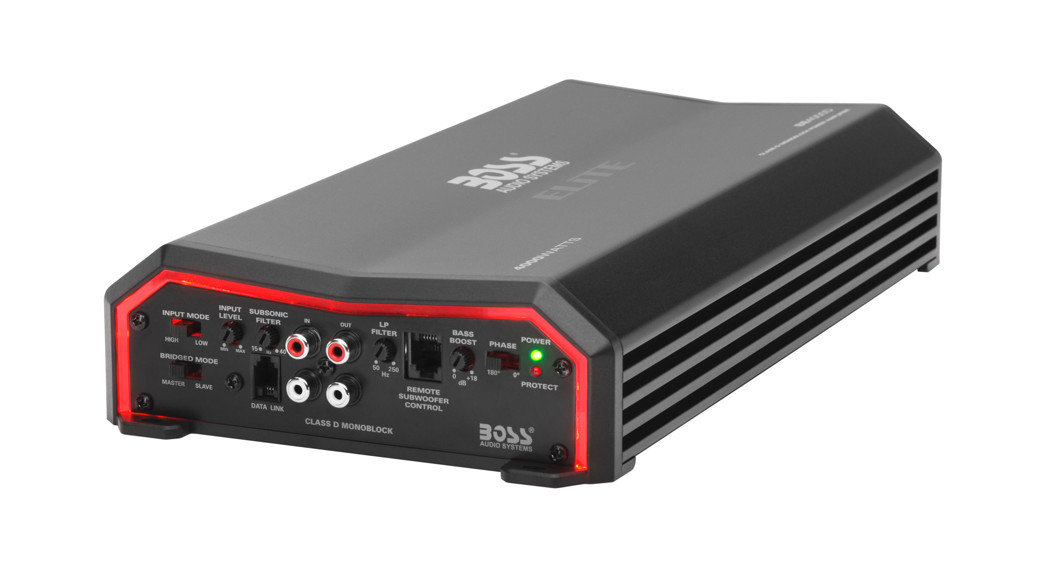
USER’S MANUALCLASS D MONOBLOCK POWER AMPLIFIR BE4000D
Congratulations on your purchase of a ![]()
![]()
![]()
![]()
![]()
![]()
![]()
![]()
![]()
![]()
![]()
![]()
Introduction
With the ![]()
![]()
![]()
![]()
![]()
![]()
![]()
![]()
![]()
![]()
![]()
![]()
Features
Your new BOSS amplifier features the following:
- Class D Topology
- MOSFET PWM (BOSS Width Modulated) Power Supply
- 10 stable mono operation
- Thermal, overload, and speaker short protection
- Soft turn-on circuit
- Remote turn-on/turn-off circuit
- Variable input gain control
- Input voltage sensitivity selector
- Variable subsonic filter: 15-40 Hz, 12dB/octave
- Variable low pass filter: 50-250 Hz, 12dB/octave
- Variable 0-+18dB Bass Boost
- 0/180° Phase Shift selector
- Nickel-plated RCA low-level inputs
- Nickel-plated speaker and power terminals
- LED power and protection indicators
- Black anodized heatsink
- Remote subwoofer control
What is included?
When first unpacking your new amplifier, please check first that the package contains all of the items below. If something is missing, contact the store where you purchased the amplifier.
- Class D amplifier
- Remote subwoofer control
- Remote subwoofer control cable
- DataLink cable (for strapping two identical BOSS Class D amps together)
- Four (4) mounting screws
General precautions
Before installing and using your new BOSS amplifier, please become familiar with all the information contained in this manual.
Please keep this manual in a safe place for future reference.
- Do not open or attempt to repair this unit yourself. Dangerous high voltages are present which may result in electric Refer any repairs to a qualified service technician.
- To avoid risk of electric shock or damage to the amplifier, do not permit any of this equipment to become damp or wet from water or drinks. If this does occur, immediately unplug the power wires and send the amplifier to your local dealer or service center as soon as possible.
Installation precautions
Before you drill or cut any holes, investigate your car’s layout very carefully. Take special care when you work near the gas tank, fuel lines, hydraulic lines, and electrical wiring.Never operate the amplifier when it is unmounted. Attach all audio system components securely to prevent damage, especially in an accident.Before making or breaking power connections in your system, disconnect the vehicle battery. Confirm that your head unit or other equipment is turned off while connecting the power and/or speaker(s).If you need to replace the power fuse, replace it only with a fuse identical to that supplied with the amplifier. Using a fuse of a different type or rating may result in damage to your audio system or your amplifier which is not covered by the manufacturer’s warranty.
Mounting the amplifier
- Find a suitable location in the vehicle in which to mount the amplifier.
- Make sure there is sufficient air circulation around the intended mounting location.
- Mark the location for the mounting hole screws by positioning the amplifier where you wish to install it. Use a scribe or mounting screw, inserted through each of the amp’s mounting holes, to mark the mounting surface. If the mounting surface is carpeted, measure the hole centers and mark with a felt tip pen.
- Drill pilot holes in the mounting surface for the mounting screws. Place the amplifier in position, and attach the amplifier to the mounting surface securely using screws.
Connecting the amplifier
Before doing any wiring, look through this manual and identify the diagrams to follow for power, input, and speaker connections for your particular installation. Be sure you understand all the connections before you proceed.
- Connect the amplifier’s power ground terminal to the closest point on the chassis of the car. Keep this ground wire to less than 39″ (100 cm) in length. Use 4 gauge (or heavier)wire.
- Connect the remote terminal to the remote output of the head unit using 16 gauge (or larger ) wire.
- Connect an empty fuse holder within 18″ (45 cm) of the car battery, and run 4 gauge cable from this fuse to the amplifier location.The purpose of placing a fuse in this location is to protect your vehicle’s battery in the event that this wire accidentally touches the chassis ground on its run to the amplifier.
- Check that the fuse holder is empty. Then connect the fuse holder to the “BATT+” connection on the amplifier.
- If multiple amplifiers are being used in your system, either:• Run a separate pair of cables from the battery and a chassis ground point to each amplifier. Each (+) cable must have its own inline fuse. -or-• Run a #0 cable from the fuse holder at the battery to a distribution block at or near the amplifier’s location. Then run separate cables from the amplifier to this distribution block and to independent chassis ground points.
- Connect all line inputs and outputs (if used) using high-quality cables. Connect all speakers, following the diagrams in this manual. Be sure to observe proper polarity to avoid audio phase problems.
- Insert fuse(s) into the battery fuse holder(s).
- Recheck all connections before powering up the amplifier
- Set all level controls to minimum position, and set all crossover controls/switches to the desired frequency points.
- Power up the head unit and the Then set the volume control on the head unit to about 3/4 volume, and adjust the amplifier’s input level control(s) to just below the level of distortion
- Further fine-tuning of the various controls may be necessary to obtain the best results.
Important installation considerations for using this amplifier.
Your BOSS Class D amplifier is designed to run with a minimum load of 10 .Operating below a 1 impedance will damage the amplifier. This damage is not covered under warranty.
BE4000D:120 A(40 A x 3)The fuse ratings for this amp is:Although sufficient for normal working conditions, overloading the amp may result in blown fuses. Please try to avoid overloading the amp in this manner.
Don’t misuse the level control!Do not mistake the input level control for volume control! It is designed ONLY to match the output level of your audio source to the input level of your amplifier.Do not adjust this input level to maximum unless your input level requires it.Ignoring these instructions will result in an input overload to the amplifier and excessive audio distortion. It can also cause the protection circuit to engage.
Tips for making your system as safe as possible
When making electrical connections to the amplifier, please observe the following:
- Always use 4 gauge or larger wire for power and ground connections.
- Wire the amplifier directly to the car Make sure there is circuit protection (such as a fuse) on the positive power lead within 18″ of the battery.
- When making a ground connection, always use the shortest possible wire to a good chassis ground point.
- Wire the remote turn-on connection to the remote turn-on lead of your EQ or head In some cases, this may be the power antenna lead of the head unit.
- Fuses protect BOTH the amplifier and the electrical system of your vehicle from faulty conditions. If you must replace a fuse on the amplifier, you must use a fuse of exactly the same type and rating. A different type of fuse or rating may result in damage or cause a fire.
SHOCK HAZARD! Do not open the case of this product. There are dangerous voltages present within the unit. There are no user-serviceable parts within the unit.
Low-Level Input Wiring
Low-level (RCA) input wiring is preferred for best audio performance. Always use a high-quality RCA cable for the best audio performance.
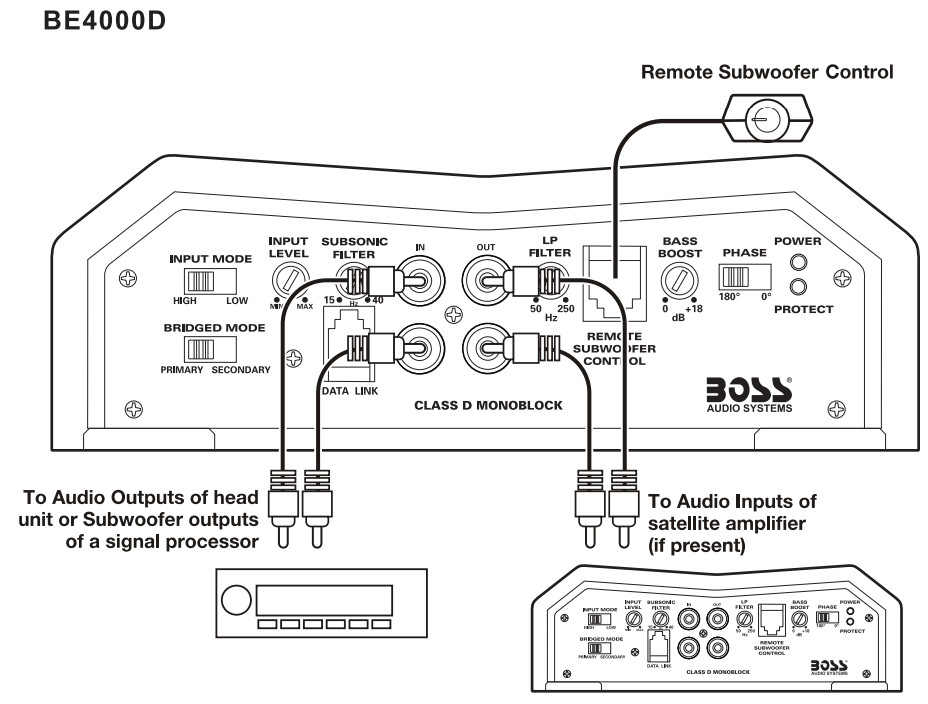

Speaker Connections


Power Connections
Without Stiffening Capacitor
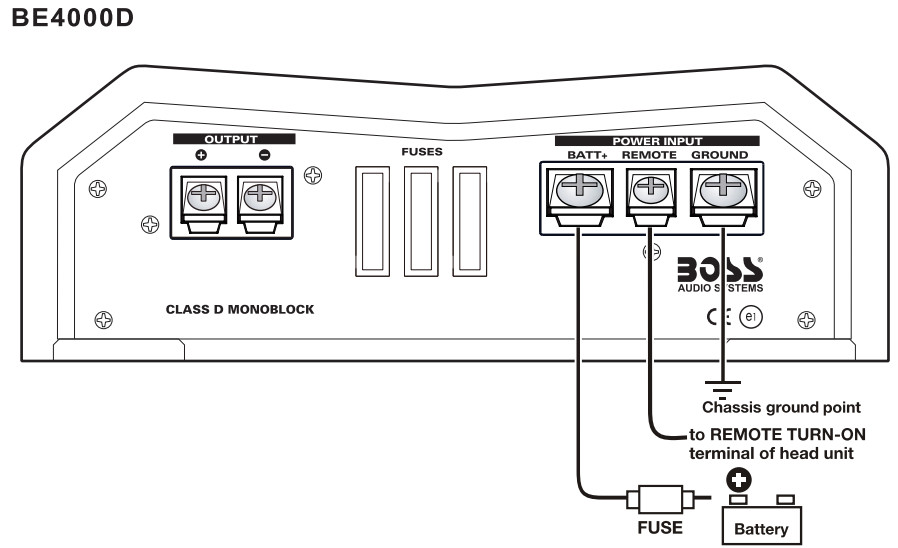

Without Stiffening Capacitor
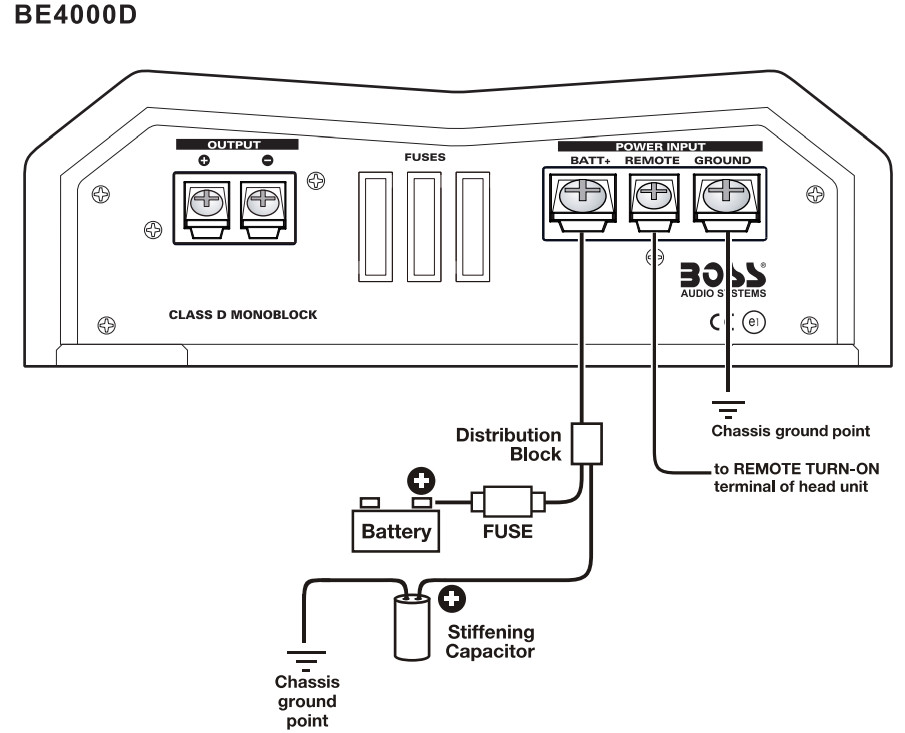

Strapping Two BE4000D Amplifiers
INPUT CONNECTIONS (SEE NEXT PAGE FOR POWER AND SPEAKER CONNECTIONS)
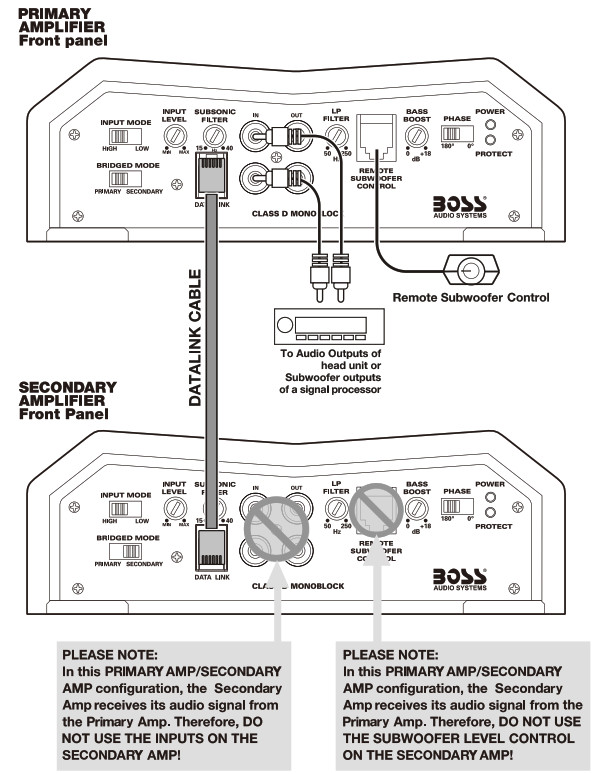

POWER AND SPEAKER CONNECTIONS (SEE PREVIOUS PAGE FOR INPUT AND DATALINK CONNECTIONS)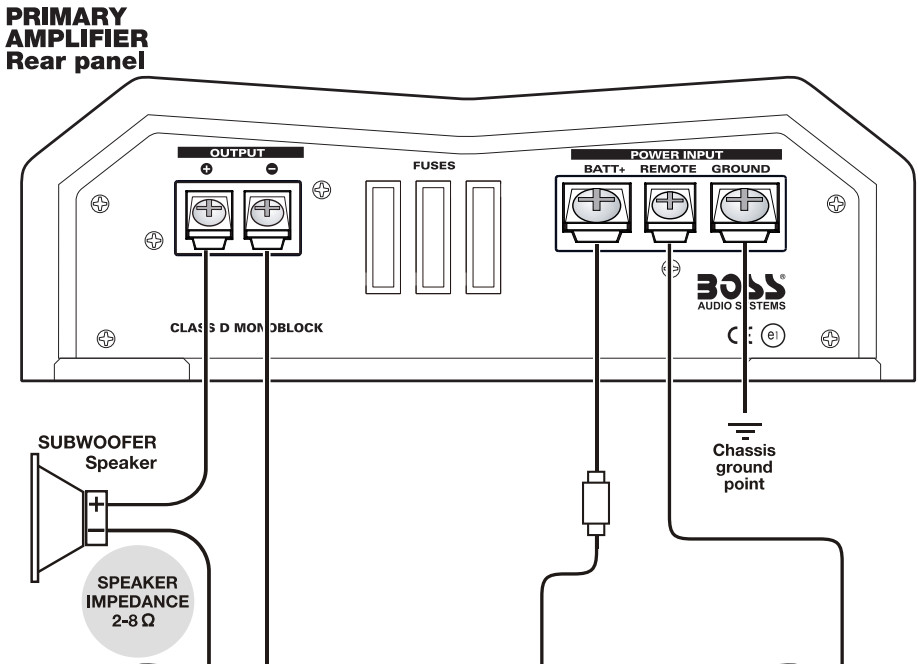

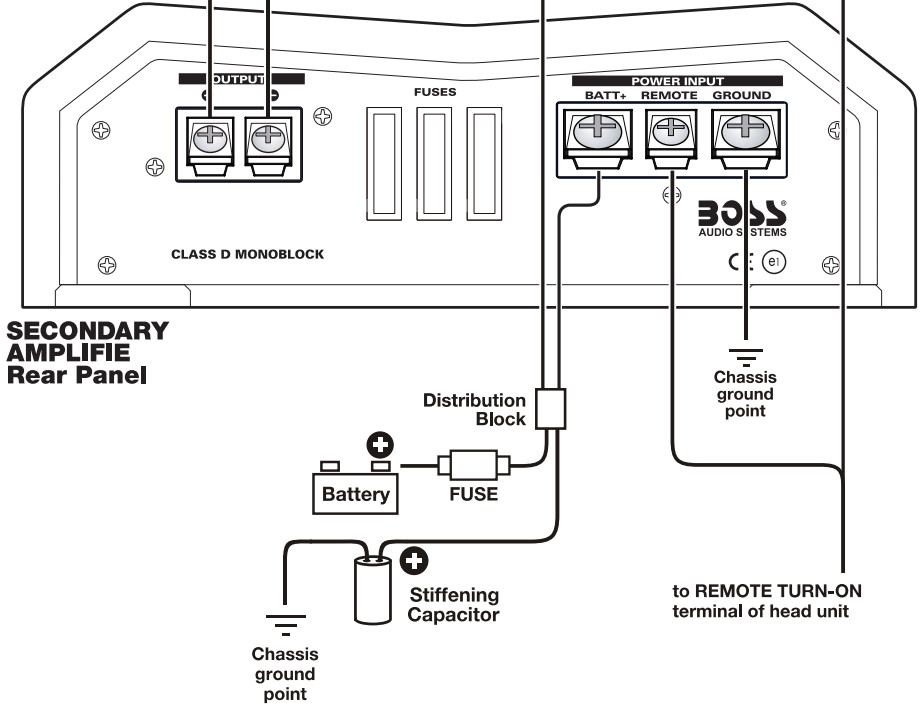

Troubleshooting
If you experience operation or performance problems with this product, compare your installation with the electrical wiring diagram on the previous pages. If problems persist, read the following troubleshooting tips which may help eliminate the problems.
SYMPTOM POSSIBLE REMEDY
| The amplifier will not power up. | Check to make sure you have a good ground connection. Check that the Remote Input (Turn-On) has at least 9VDC. Check that there is battery power on the (+) terminal. Check that there is at least 12v.Check all fuses, replace if necessary.Make sum that the Protection LED is not illuminated. If it is lit, shut off the amplifier briefly, and then repower it. |
| Protection LED comes on when the amplifier is powered up. | Check for short circuits on speaker leads.Turn down the volume control on the head unit to prevent overdriving.Remove speaker leads, and reset the amplifier. If the Protection LED still comes on, then the amplifier is faulty and needs servicing. |
| No output. | Check that the PRIMARY/SECONDARY switch is on PRIMARY ( in single-amplifier installation).Check that all fuses are OK.Check that amplifier is properly grounded.Check that the Remote Input (Turn-On) has at least 9VDC.Check that the RCA audio cables are plugged into the proper inputs. Check all speaker wiring. |
| Low output. | Reset the Level Control.Check the filter Control settings. |
| Audio present in only one channel. | Check the RCA interconnect cables. Check all speaker wiring. |
| High hiss in the speakers. | Disconnect all RCA inputs to the amplifiers. If the hiss disappears, then plug in the component driving the amplifier and unplug its inputs. If the hiss disappears at this point, go on until the faulty/noisy component is found.
It is best to set the amplifier’s input level control as low as possible. The best subjective signal-to-noise ratio is achieved in this manner Try to set the head unit as high as possible (without distortion) and the amp input level as low as possible. |
| Squealing noise from speakers. | Check for improperly grounded RCA interconnects. |
| Distorted sound. | Check that the Input Level Control is set to match the signal level of the head unit. Always by to set the Input Level as low as possible.
Check that all crossover frequencies are properly set. Check for short circuits on the speaker leads. |
| Amplifier gets very hot. | Check that the minimum speaker impedance for the amp model is correctCheck that there is good air circulation around the amp. In some applications, it may be necessary to add an external cooling fan. |
| Engine noise (static type) | This is usually caused by poor quality RCA cables, which can pick up radiated noise. Use only the best quality cables, and route them away from power cables. |
| Engine noise (alternator
whine) |
Check that speaker leads are not shorted to the vehicle chassis. Check that the RCA grounds are not shorted to the vehicle chassis. Check that the head unit is properly grounded. |
CLASS D
Monoblock Car Audio Amplifier
MODEL: BE4000D
MAX POWER 41) 20 (up to): 2000 W x1MAX POWER 0 1 0 (up to): 4000 W x 1Min. Speaker Impedance: 1 Ω MonoTHD+N: ≤0.01 %Input Impedance: 20 k ΩInput: SelectableSensitivity: 100 mV-2 Vor 2V-8VFrequency Response: 15Hz -250HzSIN Ratio: >100 dBLow Pass Filter: 50 Hz -250HzSubsonic: 15Hz -40HzBass Boost: Variable 0 -+ 18 dB @45Hz Phase Shift: Selectable 0/180°Fuse Rating Dimensions(. x W x H): 13.90″x 7 “x 2.4”Weight: 7.0Ibs/3.2kg
All specifications are subject to change without notice.![]()
![]()
![]()
![]()
![]()
![]()





[xyz-ips snippet=”download-snippet”]

